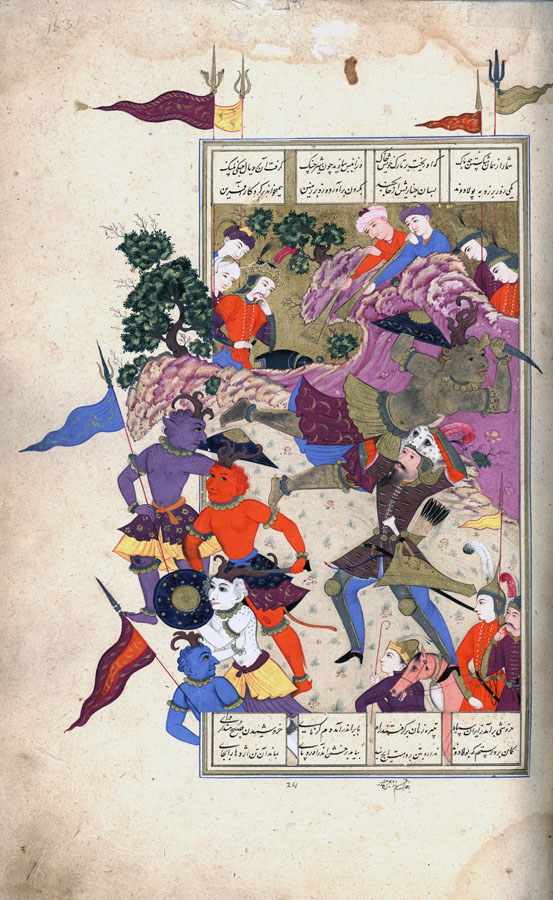Rostam Vanquishes Pulādvand
Depicted is the moment when, during their wrestling match, Rostam has uprooted Pulādvand and is about to dash him to the ground. Rostam, in his familiar tiger and leopard skins, stands in the lower right. Bracing himself, he raises the giant div Pulādvand over his head in order to pitch him into the dust. The div, his arms and legs waving in the air, holds a shield and a dagger. He is naked to the waist with skin of a light brown hue, and wears only a short double layered skirt and some bracelets on his arms, ankles, and neck. Four other divs of varying hue - vermillion, white, purple, blue - and similarly attired, carry shields, knives, and standards, beat a hasty retreat to the left. The divs are portrayed in similar manner to folio 12v: humanoid with large heads, beaked noses, pointed ears, curly hair, and antlers. In the lower right is a groom, the forequarters of a horse, and two soldiers, probably Iranian, wearing helmets. Their lower extremities are cropped making it unclear with whom to associate the horse. The backdrop is a barren, light beige colored hillside, with tiny tufts of grass evenly dispersed, which slopes upward to the left and forms a craggy rock crest about two thirds of way up the picture. The rock formation carries over into the left margin with a small bush at the top of it. Behind the crest, on the left, is the mounted figure of Afrāsiyāb with his finger to his lip in astonishment. He is accompanied by two turbanned individuals who peer over his shoulder. Beyond the ridge on the right is a second ridge rendered in mauve, which reaches a fantastic crest that resembles a breaking wave. A bush grows out of the pinnacle, and four men appear behind the ridge. Two, wearing turbans, stretch over the edge blowing long horns; the others, wearing pointed helmets, are apparently Iranian soldiers.
There are two lines of four column text above, and two lines below the painting. A rectangular frame encloses painting and text, except on the left side where the frame is virtually non-existent and the illustration spills freely into the margin. Four standards protrude into the upper margin. The painting is signed in the lower margin, in miniscule characters: beżarb-e raqam zad moʿin-e moṣavver (An impression of the humble Moʿin Moṣavver). The wording is unusual, but the handwriting appears, nevertheless, to be that of Moʿin. The inscription is not dated.
Painting references:
Welch, SA_1973, no.57 (illustrated)
Welch,
AK4_1978, p.90, Ms.22, folio 163r (not ill.).
Text references:
Warner, III, p.264; Mohl, III, p.207; Levy, p.143.
Robert Eng
Last Updated: July 6, 2011 | Originally published: July 6, 2011
